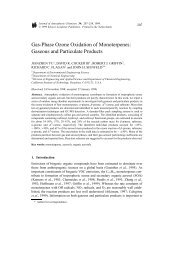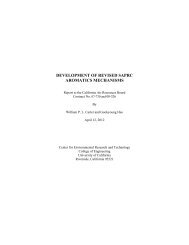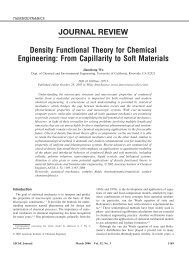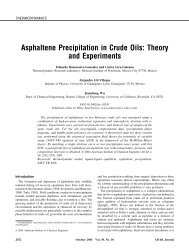ICLASS 2009, 11th International Annual Conference on Liquid ...
ICLASS 2009, 11th International Annual Conference on Liquid ...
ICLASS 2009, 11th International Annual Conference on Liquid ...
Create successful ePaper yourself
Turn your PDF publications into a flip-book with our unique Google optimized e-Paper software.
<str<strong>on</strong>g>ICLASS</str<strong>on</strong>g> <str<strong>on</strong>g>2009</str<strong>on</strong>g>, 11 th <str<strong>on</strong>g>Internati<strong>on</strong>al</str<strong>on</strong>g> <str<strong>on</strong>g>Annual</str<strong>on</strong>g> <str<strong>on</strong>g>C<strong>on</strong>ference</str<strong>on</strong>g> <strong>on</strong> <strong>Liquid</strong> Atomizati<strong>on</strong> and Spray Systems, Vail, Colorado USA, July <str<strong>on</strong>g>2009</str<strong>on</strong>g><br />
Drop Fingering <strong>on</strong> Oblique Impact: Part 1—Experimental Data<br />
Richard A. Jepsen*, Alexander L. Brown*, Guillermo Aguilar § , and Henry Vu §<br />
*Sandia Nati<strong>on</strong>al Laboratories<br />
PO Box 5800<br />
Albuquerque, NM 87185-1135<br />
§ Mechanical Engineering Department<br />
University of California, Riverside<br />
Abstract<br />
Compared with other variati<strong>on</strong>s of drop impacts, the oblique impact has received comparatively little attenti<strong>on</strong>.<br />
Most experimental work detailed in the literature has focused <strong>on</strong> the perpendicular impact while subsequently varying<br />
other parameters. Indeed, it has been theorized that an oblique impact behaves much like a perpendicular impact<br />
except with the perpendicular comp<strong>on</strong>ent of the velocity being applicable to the behavior. But an oblique splashing<br />
drop preferentially splashes in the directi<strong>on</strong> of travel (comp<strong>on</strong>ent parallel to the surface). Very little informati<strong>on</strong><br />
exists to help describe how angled drop impacts differ from the perpendicular impacts. Motivati<strong>on</strong> to better understand<br />
large-scale impacts has led to increased c<strong>on</strong>cern regarding these phenomena. Resources have been invested in<br />
experiments and modeling efforts to better describe the oblique splash problem.<br />
Experiments spanned a range of c<strong>on</strong>diti<strong>on</strong>s that involve between 0.2 and 10 cm diameter drops, velocities ranging<br />
from about 1 to 20 m/s, and impact angles from 90º to 45º (from horiz<strong>on</strong>tal). Data were recorded with high speed<br />
video for velocities of the spreading edge and splash at all locati<strong>on</strong>s around the circumference of the impact regi<strong>on</strong>.<br />
In additi<strong>on</strong>, instability c<strong>on</strong>diti<strong>on</strong>s were also evaluated. A significant database has been compiled that includes all<br />
relevant test parameters and measurements for each case. This work provides important new insight in which models<br />
can be developed for predicting impact, spreading and splash for angled impact.<br />
Introducti<strong>on</strong><br />
Large Weber number impacts are potentially encountered in transportati<strong>on</strong> accidents, deliberate strikes like the<br />
attacks of September 11, 2001, and in some large industrial fluid applicati<strong>on</strong>s. Because of the complexity, we strive<br />
to develop tools that can aid in the analysis of such events. A good literature review to this end is available in a recently<br />
completed document by Rein [1]. The perpendicular impact has been well studied while less attenti<strong>on</strong> is<br />
given to the oblique problem studied here. Indeed, in his recent review, Yarin [2] states in his c<strong>on</strong>clusi<strong>on</strong>s that “the<br />
c<strong>on</strong>sequences of oblique impacts <strong>on</strong> dry surfaces are still insufficiently studied and understood.” Since the review,<br />
there have been several studies that focus <strong>on</strong> small Weber number impacts without splashing [3-6]. But, in general<br />
agreement with this assessment for splashing drops, we have performed several series of tests aimed at discovering<br />
and quantifying the behavior of fluids impacting <strong>on</strong> surfaces at a large range of We where We =ρ f VD/σ with ρ f being<br />
the fluid density and the velocity V is the perpendicular vector to the impact surface. The intent is to develop a reas<strong>on</strong>ably<br />
accurate model for implementati<strong>on</strong> in a spray code. Because the model must be capable of predicting milli<strong>on</strong>s<br />
to billi<strong>on</strong>s of drops, some empirical assumpti<strong>on</strong>s may be acceptable.<br />
Because of complexity, data derived from impact studies are normally limited to that which can be extracted<br />
from photometric analysis. Size and form of the drop after impact is readily extractable from images. Splashing can<br />
generally be resolved. More energetic impacts will result in instabilities in the spreading drops, or fingers. These<br />
have been evaluated in the past by this research group for perpendicular impacts [7-8]. The previous work is extended<br />
by several test series focusing <strong>on</strong> oblique impacts. This report focuses <strong>on</strong> the fingering instabilities and the<br />
variati<strong>on</strong>s occasi<strong>on</strong>ed by the impact being oblique. In Part 2 of this paper series, a model is described that predicts<br />
the behavior of these data.<br />
________________________________<br />
*Corresp<strong>on</strong>ding author: rajepse@sandia.gov
<str<strong>on</strong>g>ICLASS</str<strong>on</strong>g> <str<strong>on</strong>g>2009</str<strong>on</strong>g><br />
Drop Fingering <strong>on</strong> Oblique Impact: Part 1—Experimental Data<br />
Materials and Methods<br />
Drop impact tests were d<strong>on</strong>e for a variety of liquids with impact angles from 90º to 45º (from horiz<strong>on</strong>tal). Three<br />
test facilities were utilized to accommodate drop sizes from 0.2 to 10 cm, different liquids, and ambient pressures<br />
ranging from 0.3 to 3 atm. In all cases, data were recorded with high speed Phantom digital cameras supplied by<br />
Visi<strong>on</strong> Research. Frame rates varied form 4,000 fps to 17,000 fps. The number of fingers were counted at a radius of<br />
2 to 3 drop diameters and verified by at least three observers from photometric images. The set-up for each test facility<br />
will be described separately below.<br />
Small Droplet, Ambient Pressure<br />
Drop impact measurements for small water and water–glycerin mixture droplets were c<strong>on</strong>ducted at the Photometric<br />
laboratory at Sandia Nati<strong>on</strong>al Labs. The droplets were created utilizing a dropper elevated above a smooth, 1<br />
cm thick Plexiglas impact plate approximately 15 cm by 15 cm in size. The test series also included impacts <strong>on</strong>to<br />
roughed surfaces, but those results are not presented herein. The droplets were generally 4 mm in size and the impact<br />
velocity was c<strong>on</strong>trolled by varying the drop height above the impact plate. The cameras were placed below the<br />
impact plate where forward lighting was used to illuminate the droplet impact regi<strong>on</strong>. Ambient pressure at the lab<br />
facility for these experiments was approximately 0.85 atm due to an elevati<strong>on</strong> of 1,700 m. Most tests were repeated<br />
between 4 and 10 times to generate an appropriate statistical sample.<br />
Small Droplet, Pressure Vessel<br />
Drop impact measurements as a functi<strong>on</strong> of pressure were c<strong>on</strong>ducted using an aluminum pressure chamber at the<br />
University of California Riverside Transport Phenomena Lab. This chamber was specifically designed and built to<br />
study the impact dynamics and heat transfer of liquid droplets under various pressure c<strong>on</strong>diti<strong>on</strong>s, which cover the<br />
ranges of 20% below and 500% above atmospheric pressure. Two acrylic or quartz windows were mounted <strong>on</strong> both<br />
ends of the pressure chamber for imaging and illuminati<strong>on</strong>. Acrylic towers with different heights were used to obtain<br />
various droplet impact velocities ranging from 0.5 to 5.0 m/s. A commercial droplet generator (741 MD-SS, EFD<br />
Inc., East Providence, RI) was mounted <strong>on</strong> top of the acrylic tower to generate droplets of ~ 2 mm for water.<br />
Imaging of the droplet impact phenomena was performed using a high-speed Phantom camera set at 10,000 fps.<br />
Lighting was provided by high-intensity tungsten halogen lamps. In order to fully capture the impact dynamics, imaging<br />
was performed both laterally and vertically as shown in Figure 1. Only <strong>on</strong>e camera was available for this test<br />
series, so the experiments were repeated for each camera positi<strong>on</strong>. Splashing phenomena were relatively c<strong>on</strong>sistent,<br />
so this did not present a problem. Because of the restricti<strong>on</strong>s of the pressure chamber, vertical images from below<br />
the impact surface were obtained using a mirror at preset angles to obtain a perpendicular image as shown in Figure<br />
2. Between 2 and 4 duplicate runs were performed for each setting to c<strong>on</strong>firm repeatability.<br />
Figure 1. Camera and lighting c<strong>on</strong>figurati<strong>on</strong>s for splash (lateral) and finger (vertical) imaging.
<str<strong>on</strong>g>ICLASS</str<strong>on</strong>g> <str<strong>on</strong>g>2009</str<strong>on</strong>g><br />
Drop Fingering <strong>on</strong> Oblique Impact: Part 1—Experimental Data<br />
90 o c<strong>on</strong>figurati<strong>on</strong> 45 o c<strong>on</strong>figurati<strong>on</strong><br />
Figure 2. Impact surface and mirror c<strong>on</strong>figurati<strong>on</strong>s for finger imaging.<br />
Large Diameter, High We Tests<br />
The large diameter drop impact tests were c<strong>on</strong>ducted at the outdoor Sandia Drop Tower facility. The liquid was<br />
delivered to the impact plate in a spherical latex c<strong>on</strong>tainer (i.e. water ballo<strong>on</strong>) in order to keep the liquid intact prior<br />
to impact. Immediately prior to impact, the latex was removed via sharp blade at the center of impact. For these,<br />
three different puncturing blades c<strong>on</strong>figured at 75, 60 and 45 degrees from horiz<strong>on</strong>tal were used <strong>on</strong> the angled drop<br />
test series. The blades were mounted <strong>on</strong> to the center of a 2.5 cm thick by 1.25 m l<strong>on</strong>g by 1.25 m wide smooth Lucite<br />
table top positi<strong>on</strong>ed approximately 25 cm below the diffuser plate. Since the table top was rotated and setup at<br />
different angles the spike angle c<strong>on</strong>figurati<strong>on</strong> compensated for the angle of the table. The diffuser plate c<strong>on</strong>taining<br />
the oval shape hole in the center of the plate was positi<strong>on</strong> directly above the spike. The Lucite table top and diffuser<br />
plate were supported in place by a steel angle ir<strong>on</strong> frames mounted <strong>on</strong> to a set of adjustable tri-pod stands placed <strong>on</strong><br />
top the drop tower steel target; see Figure 3(a). Cameras were located underneath and to the side of the impact target<br />
table. The side camera was for an overall view and to verify that the latex was punctured and removed prior to<br />
the spherical liquid slug impacting the table. The ambient pressure for these tests was approximately 0.85 atm because<br />
of the higher elevati<strong>on</strong> of the test facility (1,700 m).<br />
A 10 cm internal diameter by 20 cm l<strong>on</strong>g PVC tube was attached to the bottom of the tower trolley beam shown<br />
in Figure 3(b). The purposed of the PVC tube was to hold and guide the latex c<strong>on</strong>tainer during the release. The ballo<strong>on</strong>s<br />
were placed inside the PVC tube and held in place by a thin sheet of aluminum foil that was taped to the bottom<br />
of the tube. The aluminum foil was cut with a small incisi<strong>on</strong> approximately 2 cm by 2 cm l<strong>on</strong>g cross-shape<br />
located in the center of the PVC tube. The incisi<strong>on</strong> <strong>on</strong> the foil provided minimum resistance to the latex c<strong>on</strong>tainer<br />
during the release, therefore minimizing the c<strong>on</strong>tainer distorti<strong>on</strong> and rotati<strong>on</strong>.
<str<strong>on</strong>g>ICLASS</str<strong>on</strong>g> <str<strong>on</strong>g>2009</str<strong>on</strong>g><br />
Drop Fingering <strong>on</strong> Oblique Impact: Part 1—Experimental Data<br />
(a)<br />
(b)<br />
Figure 3. Experimental setup for large scale impact testing.<br />
Results and Discussi<strong>on</strong><br />
Measurements were taken to determine the total number of fingers (N f ), number of fingers in the up hill (N f-HU )<br />
and down hill hemispheres (N f-HD ), and the number of fingers in each quadrant as shown in Figure 4. This was d<strong>on</strong>e<br />
for water over a wide range of We from 10 2 to 10 6 and at varying ambient pressure. Figure 5 shows results for the<br />
number of fingers as a functi<strong>on</strong> of We for angles from 90 to 45 degrees from horiz<strong>on</strong>tal. The experimental uncertainty<br />
for the data in Figure 5 is dependent <strong>on</strong> the We. At the higher We (>100), the uncertainty is 25% and at small<br />
We (
<str<strong>on</strong>g>ICLASS</str<strong>on</strong>g> <str<strong>on</strong>g>2009</str<strong>on</strong>g><br />
Drop Fingering <strong>on</strong> Oblique Impact: Part 1—Experimental Data<br />
(a) 90 o<br />
1000<br />
(b) 75 o<br />
10 3<br />
N f<br />
10 2<br />
10 1<br />
10 4 10 1 10 2 10 3 10 4 10 5 10 6 10 7 10 8 10 9<br />
100<br />
N f<br />
Total<br />
N<br />
fHU<br />
SNL Free Droplet<br />
UCR Free Droplet<br />
SNL Large Latex Bladder<br />
SNL Small Latex Bladder<br />
SNL Water Slug<br />
All Yo<strong>on</strong><br />
10<br />
N<br />
fHD<br />
N<br />
fQU<br />
N<br />
fQM<br />
10 0<br />
N<br />
fQD<br />
1<br />
10 100 1000 10 4 10 5 10 6 10 7<br />
We<br />
We<br />
1000<br />
(c) 60 o<br />
1000<br />
(d) 45 o<br />
100<br />
100<br />
N f<br />
N f<br />
10<br />
Total<br />
N<br />
fHU<br />
N<br />
fHD<br />
10<br />
Total<br />
N<br />
fHU<br />
N<br />
fHD<br />
N<br />
fQU<br />
N<br />
fQU<br />
N fQM<br />
N<br />
fQM<br />
N<br />
fQD<br />
N<br />
fQD<br />
1<br />
10 100 1000 10 4 10 5 10 6 10 7<br />
1<br />
10 100 1000 10 4 10 5 10 6 10 7<br />
We<br />
We<br />
Figure 5. Number of fingers (N f ) vs. We at (a) 90 o , (b) 75 o , (c) 60 o , and (d) 45 o impact angles for water impacts.<br />
Results are from the Sandia small droplet tests, UCR pressure vessel tests at 1 atm, and the Sandia drop tower tests.<br />
The results from Figure 5 dem<strong>on</strong>strate that 1) the number of fingers follow the relati<strong>on</strong>ship as described by Yo<strong>on</strong><br />
et. al. (2007) regardless of the experimental method for creating the impact event, 2) the total number of fingers decreases<br />
as impact angle goes from 90 to 45 degrees, and 3) the number of fingers in the downward directi<strong>on</strong> are c<strong>on</strong>sistently<br />
higher than the number spreading in the uphill directi<strong>on</strong>. This effect becomes more pr<strong>on</strong>ounced as the impact<br />
angle goes from 90 degrees to 45 degrees. In fact the number of fingers in the downward directi<strong>on</strong> are almost a<br />
factor of two higher when compared to the uphill directi<strong>on</strong> when the impact angle is 45 o (Figure 5d).<br />
In additi<strong>on</strong>, measurements were taken for small drop impacts at angles from 90 to 45 degrees with varying air<br />
pressure. Results of these tests are in Table 1. As observed in the test results from Figure 5, the total number of fingers<br />
decreases as impact angle goes from 90 to 45 degrees. Ratios of the hemispherical number counts are presented,<br />
with the 90 degree results being suggestive of the uncertainty for these tests (i.e., those ratios should all be ‘1’). With<br />
the added variable of pressure it was observed that the number of fingers may increase with pressure and this effect<br />
appears most pr<strong>on</strong>ounced at the 45 degree impact angles. Pressure also appears to affect the ratio of fingers formed<br />
in the uphill over the downhill directi<strong>on</strong>. In general, the ratio is decreased as a functi<strong>on</strong> of decreasing pressure. This
<str<strong>on</strong>g>ICLASS</str<strong>on</strong>g> <str<strong>on</strong>g>2009</str<strong>on</strong>g><br />
Drop Fingering <strong>on</strong> Oblique Impact: Part 1—Experimental Data<br />
significance is not unexpected based <strong>on</strong> the work in Jepsen et. al. (2006) where it was shown that air and increased<br />
air pressure can create splashing and affect fingering phenomena.<br />
Table 1. Number fingers at various pressures and We for the UCR pressure vessel tests. The drop heights and impact<br />
velocities are the same for a) and b) but the effective We changes due to impact angle.<br />
a) 18 cm drop height<br />
90 o (We~175) 75 o (We~160) 60 o (We~150) 45 o (We~125)<br />
P (atm) N f-HU /N f-HD N f N f-HU /N f-HD N f N f-HU /N f-HD N f N f-HU /N f-HD N f<br />
.3 1.02 49 .67 20 .27 19 .25 10<br />
1 .97 59 .74 33 NA NA .37 13<br />
3 1.04 49 .84 35 .83 22 .42 16<br />
b) 80 cm drop height<br />
90 o (We~600) 75 o (We~560) 60 o (We~520) 45 o (We~425)<br />
P (atm) N f-HU /N f-HD N f N f-HU /N f-HD N f N f-HU /N f-HD N f N f-HU /N f-HD N f<br />
.3 1.07 63 .83 66 .57 38 .14 25<br />
1 .87 51 .95 59 .81 56 .57 35<br />
3 .90 52 .89 51 .94 42 .63 39<br />
C<strong>on</strong>clusi<strong>on</strong>s<br />
During droplet impact events, there are many cases where the impact angle is something other than perpendicular.<br />
Understanding how impact angle affects fingering instabilities and splash is of vital importance when developing<br />
models to predict such events. The oblique impact of water droplets was studied experimentally as a functi<strong>on</strong> of<br />
We and ambient pressure. Impact angles ranged from perpendicular to 45 degrees. Drop diameters of 0.2 to 10 cm<br />
and impact velocities from 1 to 20 m/s were studied. The results of this testing dem<strong>on</strong>strates that impact angle affects<br />
the total number of fingers as well as the number of fingers spreading uphill, downhill or sideways from the<br />
impact point. The testing d<strong>on</strong>e at various pressures also dem<strong>on</strong>strates angle and pressure both affect the fingering<br />
formati<strong>on</strong>. The data base from this testing should allow for significant advances in model development for impact<br />
and dispersi<strong>on</strong> of liquid droplets.<br />
Acknowledgements<br />
The authors would like to thank Jas<strong>on</strong> Rogers and Kristen Clauss for their efforts in organizing and analyzing much<br />
of the experimental data. Sandia is a multiprogram laboratory operated by Sandia Corporati<strong>on</strong>, a Lockheed Martin<br />
Company, for the United States Department of Energy under C<strong>on</strong>tract No. DE-AC04-94AL85000.<br />
References<br />
1. Brown, A.L., Yo<strong>on</strong>, S.S., and Jepsen, R.A., “Phenomen<strong>on</strong> Identificati<strong>on</strong> and Ranking Exercise and a Review of<br />
Large-Scale Spray Modeling Technology,” Proceedings of the ASME 2008 Summer Heat Transfer <str<strong>on</strong>g>C<strong>on</strong>ference</str<strong>on</strong>g>,<br />
ASME SHTC-2008, August 10-14, 2008, Jacks<strong>on</strong>ville, Florida, USA, HT2008-56371.<br />
2. Yarin, A.L., “Drop Impact Dynamics: Splashing, Spreading, Receding, Bouncing…,” Annu. Rev. Fluid Mech.<br />
38:159-192, 2006.<br />
3. Fujimoto, H., and Takuda, H., “Entrapment of air at 45º oblique collisi<strong>on</strong> of a water drop with a smooth solid<br />
surface at room temperature:, <str<strong>on</strong>g>Internati<strong>on</strong>al</str<strong>on</strong>g> Journal of Heat and Mass Transfer, 47, 3301-3305, 2004.<br />
4. Sikalo, S., C. Tropea, and E.N. Ganic, “Impact of droplets <strong>on</strong>to inclined surfaces,” Journal of Colloid and Interface<br />
Science 286, 661-669, 2005.<br />
5. Leneweit, G., R. Koehler, K.G. Roesner, and G. Schafer, “Regimes of drop morphology in oblique impact <strong>on</strong><br />
deep fluids,” J. Fluid Mech., 543, 303-331, 2005.<br />
6. Okawa, T., T. Shiraishi, and T. Mori, “Effect of impingement angle <strong>on</strong> the outcome of single water drop impact<br />
<strong>on</strong>to a plane water surface,” Exp. Fluids 44:331-339, 2008.<br />
7. Jepsen, R.A., Yo<strong>on</strong>, SS, Demosthenous, B., “Effects of Air <strong>on</strong> Splashing during a Large Droplet Impact,”<br />
Atomizati<strong>on</strong> and Sprays, 16, 1-16, 2006.<br />
8. Yo<strong>on</strong>, S.S., R.A. Jepsen, M.R. Nissen, T.J. O’Hern, “Experimental investigati<strong>on</strong> <strong>on</strong> splashing and n<strong>on</strong>linear<br />
fingerlike instability of large water drops,” Journal of Fluids and Structures, 23, 101-115, (2007).

















